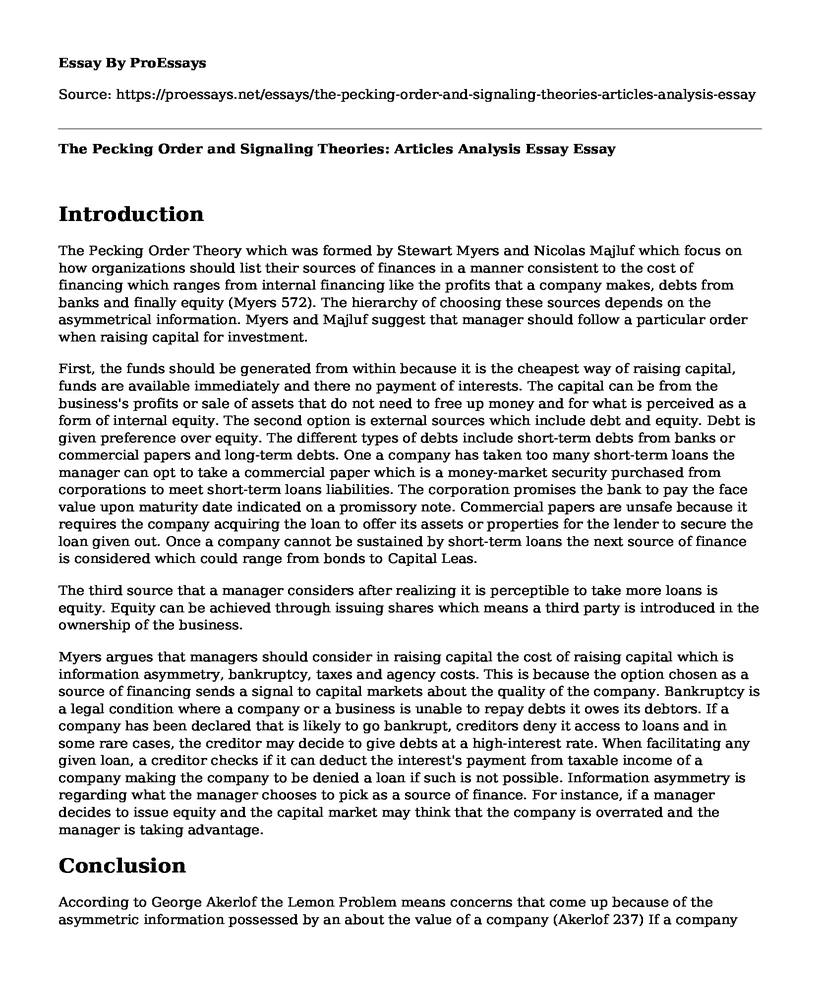Introduction
The Pecking Order Theory which was formed by Stewart Myers and Nicolas Majluf which focus on how organizations should list their sources of finances in a manner consistent to the cost of financing which ranges from internal financing like the profits that a company makes, debts from banks and finally equity (Myers 572). The hierarchy of choosing these sources depends on the asymmetrical information. Myers and Majluf suggest that manager should follow a particular order when raising capital for investment.
First, the funds should be generated from within because it is the cheapest way of raising capital, funds are available immediately and there no payment of interests. The capital can be from the business's profits or sale of assets that do not need to free up money and for what is perceived as a form of internal equity. The second option is external sources which include debt and equity. Debt is given preference over equity. The different types of debts include short-term debts from banks or commercial papers and long-term debts. One a company has taken too many short-term loans the manager can opt to take a commercial paper which is a money-market security purchased from corporations to meet short-term loans liabilities. The corporation promises the bank to pay the face value upon maturity date indicated on a promissory note. Commercial papers are unsafe because it requires the company acquiring the loan to offer its assets or properties for the lender to secure the loan given out. Once a company cannot be sustained by short-term loans the next source of finance is considered which could range from bonds to Capital Leas.
The third source that a manager considers after realizing it is perceptible to take more loans is equity. Equity can be achieved through issuing shares which means a third party is introduced in the ownership of the business.
Myers argues that managers should consider in raising capital the cost of raising capital which is information asymmetry, bankruptcy, taxes and agency costs. This is because the option chosen as a source of financing sends a signal to capital markets about the quality of the company. Bankruptcy is a legal condition where a company or a business is unable to repay debts it owes its debtors. If a company has been declared that is likely to go bankrupt, creditors deny it access to loans and in some rare cases, the creditor may decide to give debts at a high-interest rate. When facilitating any given loan, a creditor checks if it can deduct the interest's payment from taxable income of a company making the company to be denied a loan if such is not possible. Information asymmetry is regarding what the manager chooses to pick as a source of finance. For instance, if a manager decides to issue equity and the capital market may think that the company is overrated and the manager is taking advantage.
Conclusion
According to George Akerlof the Lemon Problem means concerns that come up because of the asymmetric information possessed by an about the value of a company (Akerlof 237) If a company what to raise capital through selling shares, buyers assume that the stock is overvalued even if that is not the case and that one will not be willing to buy them at the stated price.
Myers argues that informational inefficiencies in markets and actions send significant signals to market participants. When a manager decides to issue stocks it sends a signal that the value of the company is over-rated and this causes prices to go down. On the other hand, if a manager chooses to raise capital through bonds it sends a signal that it is credible and it has a promising future. Therefore, the price of stocks issued goes up.
Works Cited
Akerlof, George A. "The market for "lemons": Quality uncertainty and the market mechanism." Uncertainty in Economics. 1978. 235-251.
Myers, Stewart C. "The capital structure puzzle." The journal of finance 39.3 (1984): 574-592.
Cite this page
The Pecking Order and Signaling Theories: Articles Analysis Essay. (2022, Apr 12). Retrieved from https://proessays.net/essays/the-pecking-order-and-signaling-theories-articles-analysis-essay
If you are the original author of this essay and no longer wish to have it published on the ProEssays website, please click below to request its removal:
- Budget Issue of Police Department Case Study
- Budget Officer Requirements Paper Example
- Codification Improvements to Financial Instruments: Credit Losses Paper Example
- Research Paper on Challenges for Singapore Hospitality Industry: Hotel and Resort Guests Support for Green Initiatives
- Essay Sample on Payment Fraud: A Growing Menace for Organizations Worldwide
- Tariffs: Taxes, Protectionism, and Globalization - Essay Sample
- Essay on Nike's Gender Pay Gap: Lawsuit Implications & Analysis







